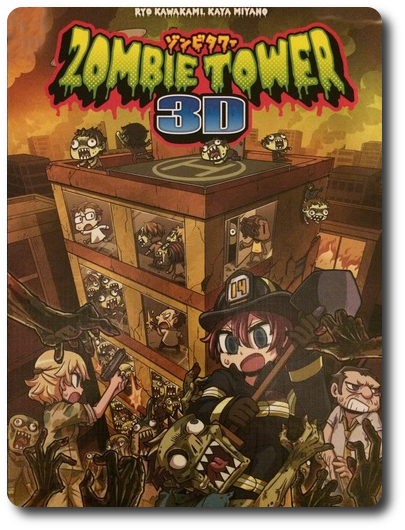
The Basics:
- For ages 8 and up (publisher suggests 10+)
- For 3 to 4 players
- Approximately 60 minutes to complete
Geek Skills:
- Active Listening & Communication
- Counting & Math
- Logical & Critical Decision Making
- Reading
- Strategy & Tactics
- Risk vs. Reward
- Cooperative & Team Play
- Hand/Resource Management
- Trading
- Area Control
Learning Curve:
- Child – Easy
- Adult – Easy
Theme & Narrative:
- A tower full of fire and zombies is not a good place to be
Endorsements:
- Gamer Geek mixed!
- Parent Geek approved!
- Child Geek approved!
Overview
Nobody can say for sure how it started, but when it did, it could not be stopped. The Zombie Invasion had begun and it spread like wildfire. Whole towns and cities were overrun in less than a day. You are a survivor and are fighting your way to safety. But fate is not on your side. There are panic-stricken people making things difficult, and of course, zombies. Lots of zombies.
Zombie Tower 3D, designed by Ryo Kawakami, Kaya Miyano, and published by Cosaic, is comprised of 4 Wall boards, 4 Joint boards, 8 Floor boards, 1 Ground board, 2 Roof-Top boards, 5 Player Character (PC) pieces, 5 PC stands, 161 Emergency chips (double-sided, Zombie on one side, Survivor on the other), 12 Damage chips, 12 Minor Objective cards, 48 Emergency cards (4 sets of 12), 4 Beginning Item cards, 15 Search cards (first floor), 17 Search cards (second floor), 15 Search cards (third floor), 8 Summary cards, 5 Character sheets, and 1 Starting Player marker. The component quality is excellent. The cards are as durable as your standard playing card, the boards are thick and durable, and the chips as made of thick cardboard, as well. The illustrations provided by artists Mana Okada and Riyo give the game a distinct popular Japanese anime feel. While cartoonish in delivery, the design elements all fit together to create a seamless visual feast. One feels like they are playing in a cartoon or a video game that has come to life on their gaming table.
Note: The game version reviewed here is difficult to find. A Kickstarter campaign was launched to make the game available to a wider audience.
Building the Tower
The most time-consuming exercise of the game is building the tower structure that will be played on. This is done by first placing the Ground board in the middle of the playing area. Once the Game board is down, the tower is built on top of it. The Wall, Joint, and Floor boards are connected via tabs and slots to create a 3-story structure. There are 2 different Roof boards. The number of players in the game will determine which is used.
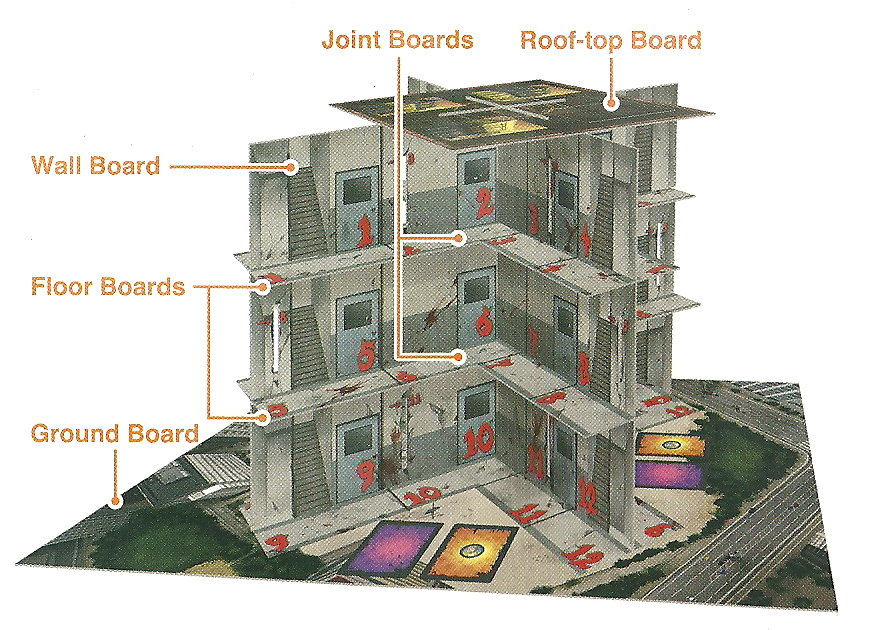
Once constructed, the players will have a three-dimensional game board to play on, complete with hallways, doors, rooms (indicated by the numbers), and stairs on no less than 3 floors with a roof. Note that there are open slots at the end of some of the hallways. This is intentional. You are not missing a piece.
I suggest two people put together the tower. While it’s possible to do with just one person, having an extra pair of hands makes the initial process of lining-up the wobbly walls and joints much easier. Once the tower if fully constructed, it is very stable.
Game Set Up
Compared to building the tower, the rest of the game set up is a breeze. However, Zombie Tower 3D has a lot of bits. If you really want to maximize your time, I suggest you have 2 players build the tower and the rest of the players complete the following.
To set up the game, first divide the Emergency chips and Damage chips into 2 different pools. I suggest small cups or bowls to keep your playing area clean.
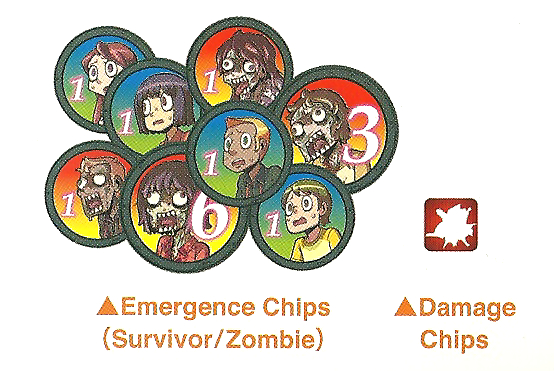
Second, separate the Search cards by floor. The back of each Search card shows a 3-story building. One floor on the building will have its lights on (leaving the other 2 floors dark). The lighted floor indicates the floor the Search card belongs to. Depending on the number of players in the game, some cards will be removed from the different floor piles. Shuffle each pile and place them, face-down, on the Roof board. There will be a designated spot for each. These are the Search draw decks for the duration of the game.
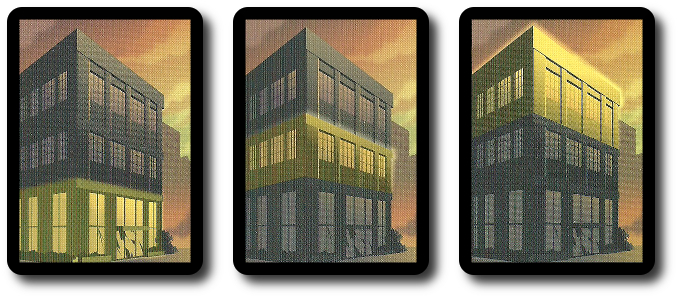
Third, either give each player a random Character sheet or have them select the one they want to use. Each Character sheet represents 1 PC in the game that is attempting to both survive and save people in the tower. Each Character sheet has a unique ability and a matching PC piece (add the PC stands at this time). In addition to the Character sheet and matching PC piece, each player should also receive a set of Emergency cards (a set includes Emergency cards numbered 1 through 12), 1 randomly distributed Beginning Item card, 3 randomly distributed Minor Objective cards, and 1 Summary card (if needed).
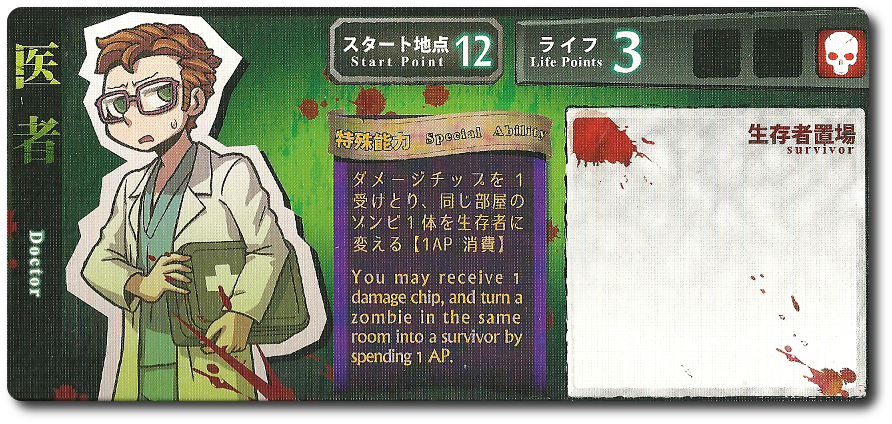
Each unique Character sheets serves as a reminder and a collection point
Fourth, each Character sheet lists the starting room the player’s PC piece is placed. For example, the “Doctor” PC piece starts in room 12. The section of the tower the player is facing is the area in which they will play. The PC pieces are placed now and the Starting Player marker is given to 1 player at random or as determined by the players.
Fifth, each player now shuffles their Emergency cards and draws the top 3, placing them face-down in front of them. Players place 1 to 6 “Zombie” Emergency chips in the rooms indicated by the Emergency cards. The number of “Zombie” Emergency chips placed depends on the determined game difficulty (Easy, Average, and Hard). The revealed Emergency cards are then added back to the player’s Emergency decks and reshuffled. Place this deck face-down in front of the player. This is the player’s Emergency draw deck.
That’s it for game set up. Time to save people and kick some zombies in the head!
Tower of Terror
Zombie Tower 3D is played in rounds and turns, with no set number of rounds per game. A single turn will include all the players in the game. Each turn is comprised of 4 sequential phases which are summarized here.
Phase 1: Emergency!
All players draw the top-most card from their Emergency draw deck and reveal it. The number of zombies shown is the number of “Zombie” Emergency chips that should be placed in the room identified by the number on the back of the card. Then the process is repeated with a new card, except this time add survivors. If a player’s Emergency draw deck is ever depleted, shuffle the discard pile to make a new draw deck.
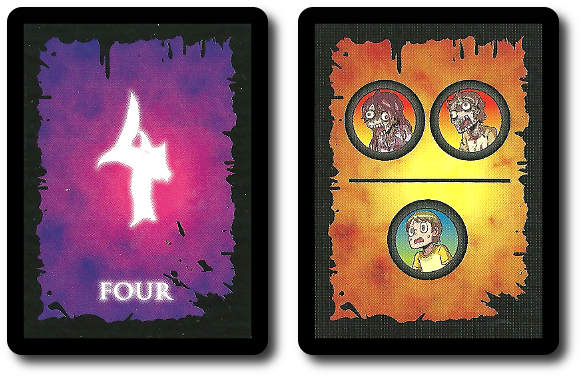
The numbers on the Emergency chips indicate the number of either zombies or survivors. Use this to “make change” when the tower starts to get overrun.
Phase 2: Action!
Starting with the player who currently has the Starting Player marker and continuing in turn order sequence, each player will spend 3 Action Points (AP) to perform 1 or more actions. The actions are summarized here. The actions can be taken in any order and can be repeated as long as the player has enough AP to pay for them. A player can, if they so choose, “purchase” 1 AP for every 1 Damage chip they place on their Character sheet.
Move (1 AP)
The Move action allows the player to move their PC piece to an adjacent room on the same floor or move up 1 or down 1 floor (if next to stairs).
Search (1 AP)
The Search action allows the player to draw 1 Search card that matches the current floor level the player’s PC piece is on. Cards go into the player’s hand. A player can announce what card they received if they want, but it’s not mandatory to do so. Some cards may instruct the player to add a “Survivor” Emergency chip to their Character sheet.
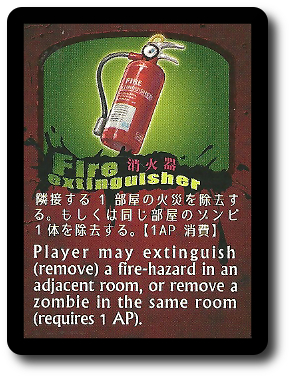
The one exception is when a Search card is drawn that states it should be announced. The game stops and the card’s text is read out loud. Once the card is resolved, it’s discarded.
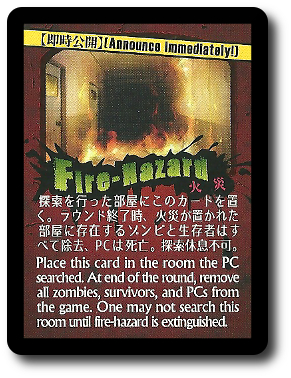
A player cannot take the Search action if their PC piece is located in a room overrun by zombies or by fire.
Rest (1 AP)
The Rest action allows the player to return 1 Damage chip located on their Character sheet and return it to the pool.
A player cannot take the Rest action if their PC piece is located in a room overrun by zombies or by fire.
Use Item (1 AP)
The Use Item action allows the player to make use of the equipment found on the cards the player is holding. Each player starts with a Beginning Item card that acts as the PC’s default item of choice. Searching will result in additional items that can be used. Some items, however, require an additional item to be played at the same time in order to work. For example, the “Handgun” can remove up to 3 “Zombie” Emergency chips, but is useless if the player doesn’t have ammo (“magazine”).
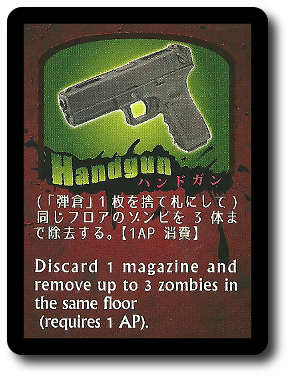
Collect Survivors (0 AP)
The Collect Survivors action allows the player to take all the “Survivor” Emergency chips located in the same room as the player’s PC piece and move them to their Character sheet.
Release Survivors (0 AP)
The Release Survivors action is just the opposite of the Collect Survivors action. The player removes “Survivor” Emergency chips located on their Character sheet and places them in the same room as their PC piece.
Handover Item (0 AP)
Located at the ends of the halls on the different floors is a small slot. This slot is just big enough to pass cards through. The Handover Item action allows the player to pass as many cards as they like to another player. Both players must have their PC pieces located at the same ends of the floor in order for this action to work. This is the only way players can exchange cards in the game.
Phase 3: ZOMBIES!
This phase belongs to the zombies. Each player will be responsible for moving the “Zombie” Emergency chips located in the same are as their PC piece. Playing area cover floors and the rooms on each floor.
If PCs and Survivors Are Not On the Same Floor
- All zombies move 1 room towards the closest PC
If Only a PC Is On the Same Floor
- All zombies move 1 room towards the closest PC
If Only Survivors Are On the Same Floor
- All zombies move 1 room towards the closest room with survivors (if equal distant from 2 or more rooms with survivors, zombies do not move)
If PCs and Survivors Are On the Same Floor
- All zombies move 1 room towards the closest room with survivors, ignoring the PC piece
Zombies will only attack if they move into a room or are located in a room with a PC piece or survivors.
Zombies vs. Survivors
- Flip over 1 “Survivor” Emergency chip for every 1 “Zombie” Emergency chip in the same room
Zombies vs. PC
- The player adds 1 Damage chip to their Character sheet per “Zombie” Emergency chip in the same room as the player’s PC piece
Zombies vs. Survivors and PC
- Flip over 1 “Survivor” Emergency chip for every 1 “Zombie” Emergency chip in the same room. For every “Zombie” Emergency chip that cannot be matched with a “Survivor” Emergency chip, the player adds 1 Damage chip to their Character sheet.
Phase 4: End of Round
When the zombies have completed their moves and attacks, the Starting Player marker is handed to the next player in turn order sequence. A new round now begins starting with phase 1 noted above.
Survival of the Fittest
The player’s win the game if either of the following 2 conditions are met.
Condition A
- Every player has a Vaccine
- One player has the Communication Device and Battery
- The round ends with all PC pieces in room #2
Condition B
- Every player has a Vaccine
- The total number of Flares is equal to the number of players
- The round ends with all PC pieces in room#10
The players have beaten the game. The Minor Objective cards are now revealed. If players completed any, they tally the number of victory points they earned. The player with the most victory points is considered the Hero of the game.
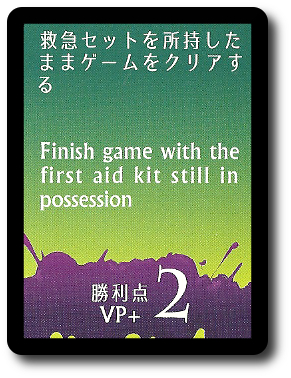
But this is not a game that wants the players to win. If any of the following conditions are met during the game, all players lose.
- If any player’s PC dies (takes too much damage)
- If any PC piece is located in a room at the end of the round that is on fire (essentially, the PC dies)
- If a round finishes and the Emergency card draw pile has run out for a second time (the players have run out of luck)
For more information, see the game’s web page.
Final Word
The Child Geeks were all for a game about zombies. Especially one where there was a giant tower game board. According to one Child Geek, “The game looks great! It reminds me of some of the video games I play.” As all of our Child Geeks were used to playing cooperative games and they starting working together immediately. They just as quickly found the tower to be a hindrance. As one Child Geek put it, “It frustrates me that I can’t go help another player with their floor!” However, all the Child Geeks also understood that their job was to protect those survivors on their floor. Cooperation came in the form of communication and trading cards, not direct action taken with guns and explosives. When the games where over, all the Child Geeks voted to approve Zombie Tower 3D and unanimously agreed that putting together the tower was a pain in the butt.
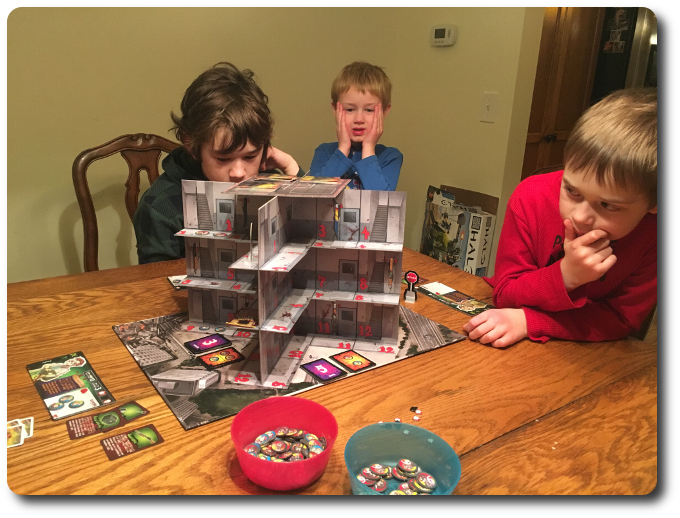
Things are not going well for the players – too many zombies and too little ammo
The Parent Geeks very much enjoyed themselves from the start and continued to enjoy the game more and more as it went on. One Parent Geek said, “Most zombie games have a lot of blood and gore, but this one reminds me of Plants vs. Zombies. It’s a game I can play and not feel uncomfortable about.” Another Parent Geek said, “It’s a bit different than other cooperative games I have played and I like how we have to pass assistance through cracks in the wall. It’s a nice touch.” All the Parent Geeks got up from the table and joined their Child Geeks when surveying the tower and enjoyed the challenge of working together with one hand tied behind their back. They also liked the hidden objective, but found that they often ignored it, focusing instead on wining the game as a group. All the Parent Geeks voted to approve Zombie Tower 3D.
The Gamer Geeks liked how the game was visually presented and the straight forward manner in which the game was played, allowing players to take full control right from the start. Unlike the other groups, the Gamer Geeks very much enjoyed the Minor Object cards. According to one Gamer Geek, “I find that these cards push me in directions I wouldn’t otherwise go. Plus, it’s a lot of fun to both work and compete against each other at the same time.” To be clear, none of the Minor Objective cards directly state that a player should put another player’s PC piece in harm’s way. What a Minor Objective will do is force a player to consider the pros and cons of helping another player in need or look to their own needs. The decision made could let the player win the game or lose the game for the group. But not everything about Zombie Tower 3D was enjoyed. According to one Gamer Geek, “The game is OK, mediocre at best. It drags and I find myself spending more time searching than taking care of zombies. A bit of a let down, really.” Another Gamer Geek said, “I don’t mind crowd control games, but this just feels like the same actions over and over again. It’s a cooperative game where I cannot cooperate as much as I want to or should be able to.” When the votes were in, the Gamer Geeks could not agree if it was a game for them or not, resulting in mixed approval.
Technically, players do not need to get up from their chair, as their PC piece will be spending all its time on the portion of the tower the player is facing. However, it’s a very good idea to get up and walk around the tower. This gives players a better perspective about what kind of trouble they are in and who they should focus on helping. This is, first and foremost, a cooperative game. The Minor Objectives are great for those who want to push their own limits, but the group comes first. If just one player’s character dies, it’s game over for everyone. Knowing how bad (or good) it is around the tower helps players make important decisions.
The game is easy to teach and to start, but begins to bog down towards the middle. About mid game you can tell if the game is beatable or not. Players will either be loaded with items and not doing anything with them or trading like crazy. In either case, the mid game is about setting up for the final act. Depending on how well-organized and driven the players are, this portion of the game is going to blitz by or feel like it’s taking forever. Not much you can do about that, as it’s just how the game goes. Nor is it a bad thing. When the energy level drops, it’s a good time to get everyone up, stretch, and go get a snack.
The only aspect of the game I disliked was the difficulty of taking out the zombies. You have to find weapons and ammo first. Then go hunt them down. All the while, players will be picking up survivors or dropping them off to act as bait while they search for something to take out the zombies. My disappointment stems from going into the game thinking I was going to kick zombie butt. This is not altogether accurate. While zombies will be destroyed, this game is more about juggling different threat levels on different floors, while all the players attempt to keep their floor orderly so they can search for necessary items. It all makes sense, really, but don’t rush into this tower thinking you’re going to be like Officer John McClane from Die Hard.
Overall I am pleased with the game. As Zombie games go, I’d say this one is about middle of the road. Once you figure out how to beat it, there really is nothing more to look forward to. The bright spot here is that the game is not easy to beat right off the bat and will keep players engaged, entertained, and challenged for some time. Visually, I really enjoyed the game, as well. Everywhere I set it up, the game drew a crowd. Zombie Tower 3D is the kind of game you see and want to play. Your level of enjoyment will be influenced by the competency of the players. If you like a good zombie survival game, where team work will win the day, do play Zombie Tower 3D. Pack some extra ammo.
Yippee-ki-yay…
This game was given to Father Geek as a review copy. Father Geek was not paid, bribed, wined, dined, or threatened in vain hopes of influencing this review. Such is the statuesque and legendary integrity of Father Geek.



